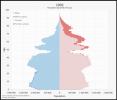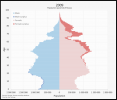Alright I'm going to give it a crack, focusing first on Russia. Note this will be very rough. The sources I have used:
1,
2,
3,
4,
5,
6
I'll first try to crack the migration numbers into and out of Russia. We had significant numbers of people leaving coupled with an
even greater number of Russians coming in from various post-Soviet states. The first assumption I make here is the number of immigrants has remained the same, but due to alternate policies we adopted which ensured the rights of Russians living in many of the breakaway states this immigrant mix has a lot more non-Russians present. Source 2 speaks upon the ratios of the populations which immigrated to Russia and since it was published in 2002 is a great insight into the '91-'00 period. By OTL 2002, out of the 25.3 million Russians who were living outside Russia, 22 million remained outside. I will assume that even with solid economic growth, due to the efforts of our government to keep Russians in the countries they were living in - instead of 3.3 million Russians entering, it was closer to 1.5 million. Source 3 highlights 6.9 million immigrants moved in - approximately half to two thirds were Russians (again a bit of a discrepancy within sources, but that is unavoidable), but this means there is a greater mix of Ukrainians, folk from Central Asia and folk from the Caucasus. Source 1, page 14 has a very simple and easy to understand table where the authors estimate that 4.1 million people emigrated compared to the official number of 2.97 million which makes perfect sense to me due to often the very illegal nature of emigration (such as trafficking). I'm going to be bold here and assume that 2.8 million out of that 4.1 million do not leave, and if they do leave they end up returning due to disillusionment with the lifestyle in the west. This reduction also includes 2/3rds of the 500-700k women who were trafficked which is a major positive for our nation (and pro-natal policies). So net gain compared to OTL at this point:
+2.8 million.
Next, looking at death rates, I will assume that more hope and availability of work coupled with our policies hitting Russian drinking culture has had some impact. Source 4 in very stark terms lets us know that of the 12 million premature deaths in the 15-69 age group between 1992-2001 (8.3 million men and 3.7 million women), had mortality rates remained the same as 1991, 2.8 million (2.14 million men, 0.63 million women) less people would have died. Additionally, had mortality decreased at the same rate as it did in the Czech Republic - a further 1.26 million (0.86 million men and 0.4 million women) less deaths would have occurred. Source 5 shows the corresponding economic growth of the Czech Republic during this time - something that can be compared to our Russia very easily and so I will use this as a basis (because not only was there comparable economic growth, but we went further and clamped down on the ridiculous alcoholism). Our efforts on the alcohol front likely had an impact because of the availability of employment, investment and general feeling of hope due to this as well as a stable political environment because without these things our efforts to curb alcoholism would have yielded nada. Not to mention we have created small scale business opportunities for local alcohol producers which ironically forces them to be more sober to sell their product well lol. So reduction in deaths/net gain compared to OTL on this front (it can be argued even more people than this survived due to significantly better conditions when compared to OTL but I don't want to completely get carried away):
+4.0 million .
Now the big one - birth rates. In '92 the TFR was 1.547 and number of births: 1.59 million for a population of 148.53 million. In '93 the TFR was 1.369 and number of births: 1.38 million. I've argued the TFR to stabilise at 1.45 by '93 before reaching 1.55 by '00. So alternate number of births in ATL '93: 1.45 million. But from here it gets really tricky. Consider that '92 had a TFR of 1.547 and '09 a TFR of 1.542 in OTL. But the number of births in '92 was 1.59 million whereas it was 1.76 million in '09 while the population had decreased to 142 million! Looking at the demographic pyramid, it's because there were basically more people in the 20-30 age range in '09 compared to '92. But I am going to assume here, this will be a period (ATL '92-'00) where women between 31-40 in OTL who didn't have children or had less children will have more here. Additionally, we'll have more couples having children in Russia who would not have existed OTL because they either died or emigrated (taking these into account for alternate birth rates is a major challenge however).
Below is the table of alternate birth numbers and TFR with OTL counterparts from source 6.
| Year | ATL TFR | ATL Births (mn) | OTL TFR | OTL Births (mn) |
| 1992 | 1.547 | 1.587 | 1.547 | 1.587 |
| 1993 | 1.45 | 1.46 | 1.369 | 1.378 |
| 1994 | 1.46 | 1.475 | 1.394 | 1.408 |
| 1995 | 1.47 | 1.499 (1.502) | 1.337 | 1.363 |
| 1996 | 1.48 | 1.52 (1.53) | 1.270 | 1.304 |
| 1997 | 1.49 | 1.54 (1.55) | 1.218 | 1.259 |
| 1998 | 1.51 | 1.573 (1.59) | 1.232 | 1.283 |
| 1999 | 1.53 | 1.605 (1.625) | 1.157 | 1.214 |
| 2000 | 1.55 | 1.642 (1.665) | 1.195 | 1.266 |
| Total Births | | 13.984 | | 12.062 |
To calculate ATL births, I took the ratio of (OTL Births/OTL TFR) which I then multiplied by ATL TFR to obtain ATL Birth numbers. The numbers in brackets in ATL Births are the number of births I think that would have occurred taking into account the additional couples that were not present in OTL (so in 1995 for example I've presumed the additional births to be 30k which grows to 200k by 1999). For total birth calculation I use the numbers in the brackets which I think would be a truer representation of birthrates (so I used 1.625 instead of 1.605 for 1999 for example). So increase in babies born compared to
OTL: +1.982 million.
Combining all this gives us a population increase of
8.78 million compared to OTL Russia in 2000, whose population was 146.89 million. Therefore population of ATL Russia, 2000:
155.67 million.
For Belarus, I'm feeling a bit lazy lol. So I'm going to do:
% change of Russian population compared to OTL: +5.98% (8.78*100/146.89)
Increase in Belarusian population with same rate: 0.597 million (9.98*0.0598)
Therefore population of ATL Belarus, 2000:
10.58 million.
All in all, population of Union State, 2000:
166.25 million.
(Phew, that took a while lol).

